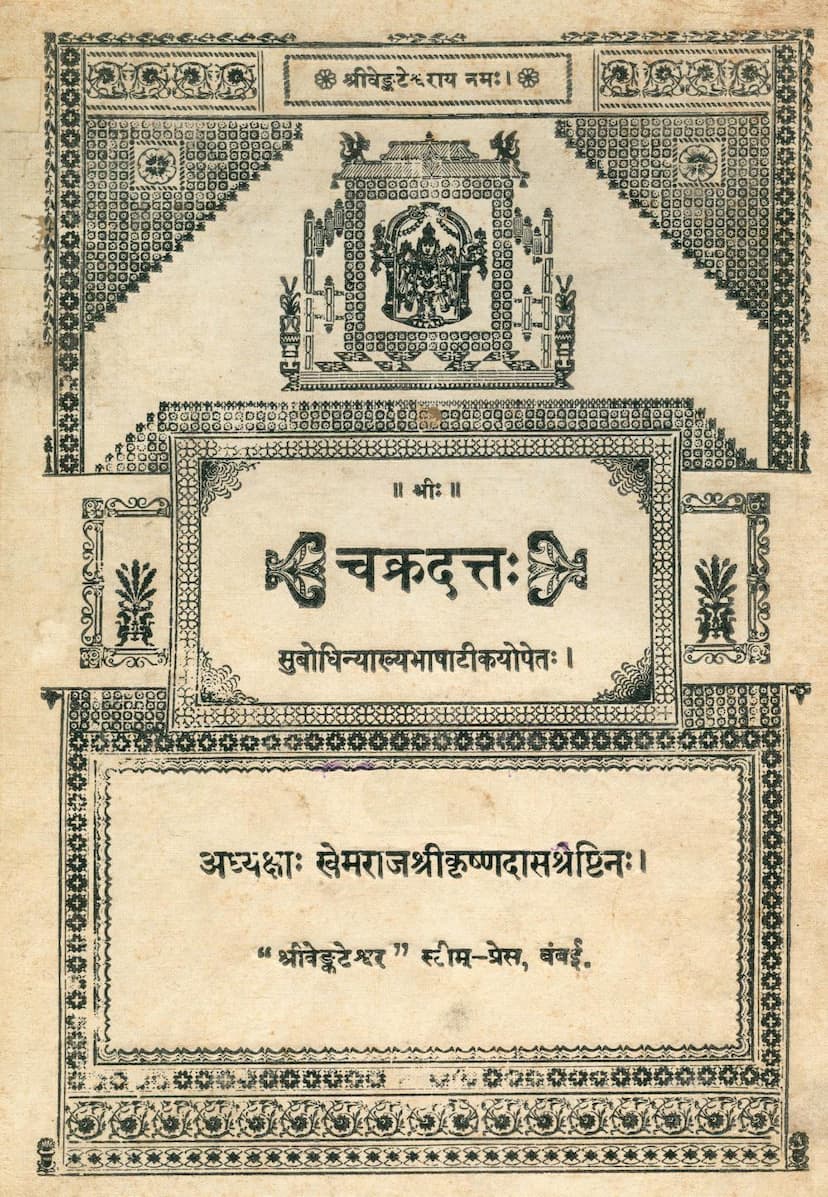Chakradutt
Added to library: September 1, 2025

Summary
Based on the provided text, here's a comprehensive summary in English of the Jain text "Chakradutta," authored by Jagannathsharma Bajpayee Pandit and published by Lakshmi Vyenkateshwar Steam Press:
Book Title: Chakradutta (चक्रदत्तः) Author: Jagannathsharma Bajpayee Pandit (जगन्नाथशर्मवाजपेयी पण्डित) Publisher: Lakshmi Vyenkateshwar Steam Press (लक्ष्मी वेङ्कटेश्वर स्टीम प्रेस) Catalog Link: https://jainqq.org/explore/032136/1
Overall Summary:
"Chakradutta," also known as "Chakrapanidatta," is a foundational Ayurvedic text in the Jain tradition, specifically focusing on the practical aspects of pharmacology and therapeutics. While the catalog link points to a Jain resource, the text itself is a well-known Ayurvedic treatise originally compiled by Chakrapani Datta. The edition summarized here features a Hindi commentary called "Subodhini" (सुबोधिनी) by Pandit Jagannath Sharma Bajpayee, aiming to make the ancient knowledge accessible to a wider audience.
The text is essentially a compendium of Ayurvedic treatments, organized by disease. It follows the pattern of classical Ayurvedic Samhitas, likely drawing heavily from the Charaka Samhita and Sushruta Samhita, with a particular emphasis on the Chikitsa Khanda (treatment section). The author, Pandit Bajpayee, highlights the text's significance in Bengal, where it was highly regarded, and its inclusion in the curriculum of institutions like the Benares Hindu University.
Key Aspects and Contents:
-
Author and Commentary: The book presents the original work of Chakrapani Datta, a prominent Ayurvedic physician, with an explanatory Hindi commentary ("Subodhini") by Pandit Jagannath Sharma Bajpayee. Bajpayee's intention was to clarify the complex Sanskrit terminology and make the treatments understandable for modern practitioners. He notes his personal connection to the text, having been assigned to teach it as early as 1925 CE.
-
Ayurvedic Principles: The introduction (विनम्र निवेदनम्) by Bajpayee emphasizes the core Ayurvedic philosophy of achieving health ("Arogya") as the foundation for fulfilling life's goals (Dharma, Artha, Kama, Moksha). It quotes ancient texts like Agnivesha and Vagbhata to underscore the importance of Ayurveda in maintaining health and treating diseases. The text stresses the need to understand diseases thoroughly before administering medicine, citing Charaka: "First examine the disease, then the medicine, then the action, and finally the physician should act with knowledge."
-
Structure and Content: The bulk of the text, as indicated by the extensive "Vishayanukramanika" (Table of Contents), is a detailed guide to treating a vast array of diseases. It covers:
- Fever (Jvara): An extensive section detailing various types of fever (fevers caused by Ama, Niram, dual doshas, sannipata), dietary recommendations (Pathya), forbidden foods and actions, and numerous formulations like decoctions (Kashaya), powders (Churna), electuaries (Avaleha), medicated ghees (Ghrita), medicated oils (Taila), and fermented medicines (Asava Arishta).
- Digestive Disorders: Treatments for ailments like indigestion (Ajirna), and critically, Grahani (Malabsorption/Irritable Bowel Syndrome). The text explains the need to first balance doshas and then introduce appropriate dietary measures.
- Other Systemic Diseases: A wide range of diseases are covered, including:
- Diarrhea (Atisara) and Dysentery (Pravahika)
- Hemorrhoids (Arsha)
- Anorexia and Indigestion (Agni Mandya)
- Jaundice and Liver ailments (Pandu Roga, Kamala)
- Anemia
- Cough and Cold (Kasa Shwasa)
- Fistula (Bhagandara)
- Abscesses (Vidradhi)
- Various swellings and tumors (Shotha, Vruddhi, Granthi)
- Rheumatism and Arthritis (Vata Rakt, Amavata)
- Joint pains and stiffness (Urusthambha)
- Paralysis and Neurological disorders (Pakshaghata, Sarvashula)
- Herbal remedies for specific conditions.
- Treatments for eye diseases (Netra Roga), ear diseases (Karna Roga), nose diseases (Nasa Roga), and throat diseases (Kanth Roga).
- Special sections on poisoning (Visha), rejuvenation (Rasayana), and aphrodisiacs (Vajikarana).
- Treatments for skin diseases (Kushtha), including a wide variety of formulations.
- Management of abdominal diseases (Udara) and spleen disorders (Plíha).
- Specific chapters on diseases affecting women (Stri Roga) and children (Bala Roga).
- Detailed descriptions of treatments for conditions like urinary disorders (Mutra Ghat, Mutra Krichra, Ashmari), and eye infections.
- A comprehensive approach to fevers (Jvara) and their management.
- The index also lists treatments for ailments like hemorrhoids (Arsha), coughs and colds (Kasa), digestive issues (Agni Mandya), anemia (Pandu Roga), jaundice (Kamala), and various skin disorders (Kushtha).
-
Formulations: The text is rich in descriptions of various Ayurvedic pharmaceutical preparations, including:
- Decoctions (Kashaya): Mentioned frequently for fevers and other conditions.
- Powders (Churna): Used for digestive issues, fevers, and other ailments.
- Pastes (Kalka): Commonly used in formulations.
- Ghee (Ghrita): Medicated ghees are extensively described for their therapeutic properties.
- Oils (Taila): Medicaments for external application and specific treatments.
- Avaleha (Electuaries): Mentioned for coughs and fevers.
- Arishta and Asava: Fermented medicinal preparations.
- Lehyas and Vati: Pastes and pills for various ailments.
- Specific preparations like Mandura (iron-based formulations), Kshara (alkalis), and various compound medicines.
-
Emphasis on Practicality: Bajpayee's commentary and the original text itself aim for practical application. The detailed table of contents reveals an approach focused on symptomatic treatment and disease management, offering numerous formulation options based on specific conditions. The inclusion of the "Subodhini" commentary ensures that the intricate details of preparing and administering these medicines are made clear.
-
Historical Context: The text provides historical context, mentioning Chakrapani Datta's time (around the mid-11th century CE), his title "Chakrānana" (due to his commentary on Charaka Samhita), and the influence of the text in Bengal. It also touches upon the efforts of scholars like Ganannath Sen in dating and understanding these texts.
In essence, "Chakradutta" is a highly practical and comprehensive manual for Ayurvedic practitioners, offering a wealth of knowledge on treating a wide spectrum of diseases with detailed pharmaceutical recipes. Pandit Bajpayee's "Subodhini" commentary bridges the gap between ancient Sanskrit texts and modern understanding, making this vital Ayurvedic text accessible and applicable.